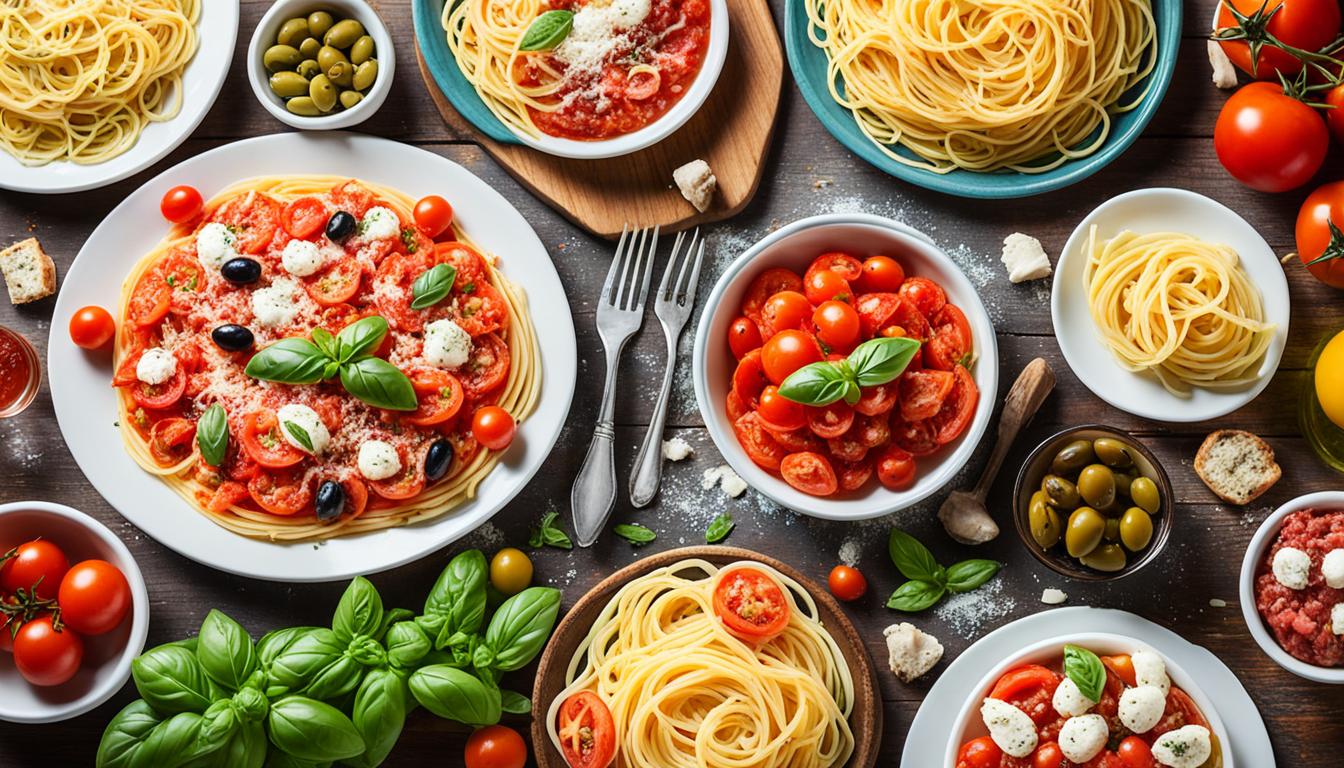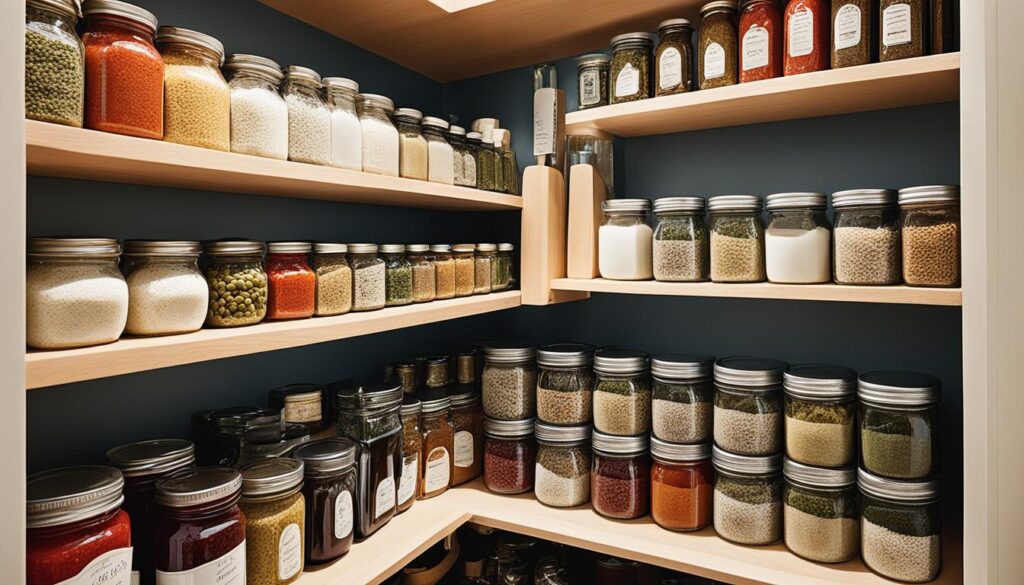
Italian Cuisine Essentials: Tips & Recipes
Have you ever been transported to another place simply by the aroma of a dish? The enticing scent of garlic gently sizzling in olive oil, or the comforting aroma of a simmering tomato sauce. These familiar smells have a way of awakening memories and emotions, taking us back to cherished moments or inspiring us to create new ones.
That’s the power of Italian cuisine. It goes beyond the mere act of cooking and eating. It’s about connecting with tradition, with the rich heritage of a country known for its love of food, family, and life itself. It’s about embracing simplicity and quality, and savoring every bite as if it were a celebration.
When I think of Italian cuisine, I picture warm gatherings around a table filled with the vibrant colors and flavors of traditional dishes. I can almost hear the lively conversations and laughter, and feel the joy that comes from sharing a meal with loved ones. It’s a feeling that transcends borders and unites people from all walks of life.
And now, you have the opportunity to bring that same experience to your own home. With the right understanding of Italian cuisine essentials, you can create mouthwatering dishes that capture the heart and soul of Italy.
- Italian cuisine is more than just food – it’s a celebration of tradition and quality.
- The aroma of Italian dishes has the power to transport us to special moments and evoke deep emotions.
- By embracing the essentials of Italian cooking, you can awaken the vibrant flavors of Italy in your own kitchen.
- Italian cuisine is about sharing meals, creating memories, and connecting with loved ones.
- Get ready to embark on a culinary journey that will delight your senses and bring a taste of Italy to your home.
Key Ingredients in Italian Cooking
Italian cuisine is known for its flavorful and diverse dishes that are enjoyed worldwide. To achieve those authentic Italian flavors, it’s important to understand the key ingredients used in Italian cooking techniques. These ingredients are the building blocks of famous Italian dishes and are essential for creating regional Italian cuisine.
One of the fundamental ingredients in Italian cooking is onions and garlic. Known for their aromatic properties, they form the base of many Italian dishes, providing depth and flavor. Whether sautéed or slowly cooked, onions and garlic add a distinct taste to pasta sauces, soups, and meat dishes.
Potatoes are another commonly used ingredient in Italian cuisine. They are versatile and can be prepared in various ways, such as being roasted, boiled, or mashed, and are often used in regional Italian dishes like potato gnocchi and fried potatoes.
Dry nuts and peperoncino (chili pepper) are also prevalent in Italian cooking. Dry nuts, such as pine nuts and almonds, add texture and nuttiness to dishes like pesto sauce and roasted vegetables. Peperoncino, on the other hand, adds a hint of heat to sauces, stews, and even pizza.
To enhance the flavors of Italian dishes, nutmeg and dry oregano are commonly used. Nutmeg, with its warm and slightly sweet taste, is added in small amounts to pasta sauces, vegetable gratins, and creamy soups. Dry oregano, with its earthy and slightly bitter notes, complements pizza, pasta, and grilled dishes.
Canned crushed tomatoes are a pantry staple in Italian households and are essential for preparing classic Italian sauces such as marinara or Bolognese. They form the base of many Italian pasta dishes and are known for their rich, tangy flavor.
When it comes to Italian cooking, olive oil is a quintessential ingredient. It is used in various culinary applications, including sautéing, dressing salads, and as a finishing touch to many dishes. The quality of the olive oil used can greatly influence the overall taste of Italian recipes.
Canned legumes, such as chickpeas, beans, and lentils, are widely utilized in Italian cuisine. They are added to soups, stews, and salads, providing a source of protein and adding heartiness to the dishes.
Regional Italian cuisine also incorporates ingredients like vinegars, capers, and high-quality canned tomatoes, which further enhance the flavors and create a unique taste in various dishes.
For Italian pasta lovers, having a variety of dry pasta and tortellini on hand is essential. These versatile ingredients allow for endless meal options and can be paired with a variety of savory sauces and fillings.
Rice and polenta are alternative staples in Italian cooking, providing variety in meal choices. Rice is commonly used for risotto dishes, while polenta is popular in northern Italy and is often served with stews or grilled vegetables.
In addition to pasta, rice, and polenta, Italian cooking requires the use of versatile ingredients like all-purpose flour and bouillon cubes. These ingredients are used to thicken sauces, create soups, and add flavor to various Italian recipes.
Famous Italian Dishes
Now that you know the key ingredients in Italian cooking, let’s explore some famous Italian dishes that showcase the rich flavors and culinary traditions of Italy:
- Pizza Napoletana – A traditional Neapolitan pizza topped with San Marzano tomatoes, mozzarella cheese, and fresh basil.
- Spaghetti alla Carbonara – A classic pasta dish made with eggs, Pecorino Romano cheese, guanciale (cured pork jowl), and black pepper.
- Tiramisu – A delightful dessert consisting of ladyfingers soaked in coffee and layered with a rich mixture of mascarpone cheese, eggs, sugar, and cocoa.
- Risotto alla Milanese – A creamy and flavorful risotto made with saffron, beef or vegetable broth, white wine, and Parmesan cheese.
- Ossobuco – A Milanese specialty of braised veal shanks served with gremolata (a mixture of lemon zest, garlic, and parsley) and saffron-infused risotto.
These famous dishes represent just a fraction of the incredible culinary heritage of Italian cuisine.
| Ingredient | Usage |
|---|---|
| Onions | Base for many Italian dishes |
| Garlic | Provides depth and flavor |
| Potatoes | Used in various preparations |
| Dry nuts | Adds texture and nuttiness |
| Peperoncino | Adds heat to dishes |
| Nutmeg | Enhances flavors with its warm and sweet taste |
| Dry oregano | Complements pizza, pasta, and grilled dishes |
| Canned crushed tomatoes | Pantry staple for Italian sauces |
| Olive oil | Quintessential ingredient in Italian cooking |
| Canned legumes | Add heartiness and protein to dishes |
| Vinegars | Enhance flavors in various dishes |
| Capers | Add a tangy element to recipes |
| High-quality canned tomatoes | Create unique taste in Italian dishes |
| Dry pasta | Versatile ingredient for numerous meal options |
| Tortellini | Pair with savory sauces and fillings |
| Rice | Used for risotto dishes |
| Polenta | Served with stews or grilled vegetables |
| All-purpose flour | Thickens sauces and creates soups |
| Bouillon cubes | Adds flavor to Italian recipes |
Having these key ingredients on hand will enable you to embark on a culinary journey through the vibrant and diverse flavors of Italian cuisine.
Stocking Your Italian Pantry
To prepare delicious Italian dinners at home, it’s important to stock your pantry with the right ingredients. Here is a list of essential items that will help you create authentic Italian recipes:
1. Onions, Garlic, and Potatoes
Store these three ingredients separately in a cool, dry place. Onions and garlic are flavor powerhouses in Italian cuisine, providing depth and aroma to dishes. Potatoes, on the other hand, are versatile and can be used in a variety of Italian recipes, from comforting soups to crispy roasted potatoes.
2. Dry Nuts, Peperoncino, and Grated Nutmeg
Dry nuts like almonds, pine nuts, and walnuts add texture and richness to Italian dishes. Peperoncino, or dried chili flakes, brings a pleasant heat to recipes like pasta arrabbiata. Grated nutmeg, a touch of warmth and complexity, enhances the flavors of stews, sauces, and creamy desserts.
3. Dry Oregano and Canned Crushed Tomatoes
Dry oregano is a staple herb in Italian cooking, providing earthy and aromatic notes to countless dishes. Canned crushed tomatoes, with their concentrated flavor, are indispensable for achieving authentic Italian tastes in sauces, soups, and stews.
4. Olive Oil, Canned Legumes, and Various Vinegars
Olive oil is the foundation of Italian cuisine, adding richness and fruity notes to dishes. Canned legumes like chickpeas, cannellini beans, and lentils are essential for making hearty Italian soups and stews. Different types of vinegars, such as red wine vinegar and balsamic vinegar, add a tangy element to dressings, marinades, and sauces.
5. Dry Pasta and Tortellini
Having a variety of dry pasta and tortellini on hand opens up a world of possibilities for quick and easy Italian meals. From classic spaghetti and lasagna to lesser-known shapes like orecchiette and farfalle, pasta is a staple in Italian cooking. Tortellini, filled pasta pockets, are great for soups and creamy sauces.
6. All-Purpose Flour, Bouillon Cubes, and Breadcrumbs
All-purpose flour is a versatile ingredient for making sauces, doughs, and batters in Italian cooking. Bouillon cubes provide a quick and flavorful base for soups and stews. Breadcrumbs add crunch and texture to dishes like parmigiana and breaded meats.
7. Fresh Ingredients: Cheese, Parsley, and Vegetables
While a well-stocked pantry is important, fresh ingredients also play a vital role in Italian cuisine. Keep cheeses like Parmigiano-Reggiano, mozzarella, and Pecorino Romano in your refrigerator for sprinkling over pasta dishes and salads. Fresh parsley adds brightness to many recipes, while seasonal vegetables bring freshness and color to Italian dishes.
By stocking your Italian pantry with these key ingredients, you’ll be well-equipped to create authentic and delicious Italian recipes in the comfort of your own kitchen.

Conclusion
With the right ingredients and knowledge of Italian cooking techniques, you can create authentic Italian dishes at home. Italian cuisine is renowned for its simplicity and emphasis on quality ingredients. By stocking your pantry with essential Italian ingredients and following traditional recipes, you can bring the flavors of Italy to your own kitchen.
Whether it’s homemade pasta or a classic tomato sauce, Italian cuisine celebrates the natural flavors of the ingredients. The secret lies in using fresh produce and letting the ingredients speak for themselves. From flavorful herbs and spices to vibrant vegetables and aromatic oils, every component plays a crucial role in creating a truly memorable dining experience.
To fully immerse yourself in the world of Italian cuisine, why not visit some of the best Italian restaurants in your area? Indulge in the diverse regional offerings, from the rich and hearty dishes of the North to the lighter and seafood-focused specialties of the South. These restaurants are a testament to the culinary legacy of Italy and will undoubtedly ignite your passion for Italian food.
So, gather your ingredients, put on some Italian music, and get ready to enjoy the delicious and satisfying experience of Italian cuisine. Buon appetito!
Source Links
- https://www.realsimple.com/food-recipes/cooking-tips-techniques/italian-cuisine
- https://www.foodandwine.com/how/italian-recipes-every-beginner-cook-should-master
- https://www.thelazyitalian.com/the-italian-pantry/

Leave a Reply